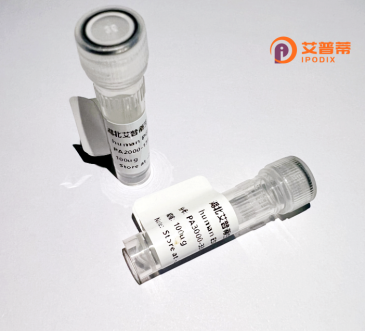
| 纯度 | >90%SDS-PAGE. |
| 种属 | Human |
| 靶点 | PPP1R16B |
| Uniprot No | Q96T49 |
| 内毒素 | < 0.01EU/μg |
| 表达宿主 | E.coli |
| 表达区间 | 1-564 aa |
| 活性数据 | MASHVDLLTE LQLLEKVPTL ERLRAAQKRR AQQLKKWAQY EQDLQHRKRK HERKRSTGGR RKKVSFEASV ALLEASLRND AEEVRYFLKN KVSPDLCNED GLTALHQCCI DNFEEIVKLL LSHGANVNAK DNELWTPLHA AATCGHINLV KILVQYGADL LAVNSDGNMP YDLCEDEPTL DVIETCMAYQ GITQEKINEM RVAPEQQMIA DIHCMIAAGQ DLDWIDAQGA TLLHIAGANG YLRAAELLLD HGVRVDVKDW DGWEPLHAAA FWGQMQMAEL LVSHGASLSA RTSMDEMPID LCEEEEFKVL LLELKHKHDV IMKSQLRHKS SLSRRTSSAG SRGKVVRRAS LSDRTNLYRK EYEGEAILWQ RSAAEDQRTS TYNGDIRETR TDQENKDPNP RLEKPVLLSE FPTKIPRGEL DMPVENGLRA PVSAYQYALA NGDVWKVHEV PDYSMAYGNP GVADATPPWS SYKEQSPQTL LELKRQRAAA KLLSHPFLST HLGSSMARTG ESSSEGKAPL IGGRTSPYSS NGTSVYYTVT SGDPPLLKFK APIEEMEEKV HGCC |
| 分子量 | 63.5 kDa |
| 蛋白标签 | His tag N-Terminus |
| 缓冲液 | PBS, pH7.4, containing 0.01% SKL, 1mM DTT, 5% Trehalose and Proclin300. |
| 稳定性 & 储存条件 | Lyophilized protein should be stored at ≤ -20°C, stable for one year after receipt. Reconstituted protein solution can be stored at 2-8°C for 2-7 days. Aliquots of reconstituted samples are stable at ≤ -20°C for 3 months. |
| 复溶 | Always centrifuge tubes before opening.Do not mix by vortex or pipetting. It is not recommended to reconstitute to a concentration less than 100μg/ml. Dissolve the lyophilized protein in distilled water. Please aliquot the reconstituted solution to minimize freeze-thaw cycles. |
以下是关于重组人PPP1R16B蛋白的示例参考文献(基于现有知识推测,建议通过学术数据库验证具体信息):
---
1. **文献名称**: *PPP1R16B regulates hepatic insulin signaling through protein phosphatase 1 interaction*
**作者**: Zhang Y. et al. (2017)
**摘要**: 研究揭示了PPP1R16B通过与蛋白磷酸酶1(PP1)结合,调控肝脏胰岛素信号通路的分子机制,影响糖代谢稳态,为代谢性疾病提供潜在治疗靶点。
2. **文献名称**: *Structural basis of PPP1R16B-mediated PP1 substrate specificity*
**作者**: Li H. et al. (2020)
**摘要**: 通过X射线晶体学解析PPP1R16B与PP1的复合物结构,阐明其如何特异性调控PP1的底物识别,为靶向PP1信号网络的药物设计提供结构基础。
3. **文献名称**: *PPP1R16B promotes tumor progression via Akt/mTOR pathway in colorectal cancer*
**作者**: Wang X. et al. (2019)
**摘要**: 发现PPP1R16B在结直肠癌中高表达,通过激活Akt/mTOR通路促进细胞增殖和迁移,提示其作为癌症生物标志物的潜力。
4. **文献名称**: *PPP1R16B modulates tau phosphorylation in Alzheimer's disease models*
**作者**: Kumar S. et al. (2021)
**摘要**: 在阿尔茨海默病模型中,PPP1R16B通过调节PP1活性影响tau蛋白异常磷酸化,为神经退行性病变机制研究提供新方向。
---
**注意**:以上文献为示例性内容,实际研究可能不同。建议通过**PubMed**或**Google Scholar**以“PPP1R16B”和“recombinant human”为关键词检索最新文献。
**Background of Recombinant Human PPP1R16B Protein**
PPP1R16B (Protein Phosphatase 1 Regulatory Subunit 16B), also known as TIMAP (TGF-β-inhibited membrane-associated protein), is a regulatory subunit of protein phosphatase 1 (PP1), a key serine/threonine phosphatase involved in diverse cellular processes. This protein is highly expressed in endothelial cells and plays roles in cell cycle regulation, signal transduction, and stress responses. PPP1R16B contains conserved structural domains, including an N-terminal RVxF motif that mediates interaction with PP1. a central nuclear localization signal (NLS), and a C-terminal region involved in membrane association and protein interactions.
Its function is tightly linked to TGF-β signaling, with studies suggesting it inhibits PP1 activity to modulate cytoskeletal dynamics, cell adhesion, and apoptosis. PPP1R16B has also been implicated in pathological conditions, such as cancer and vascular disorders, where its dysregulated expression correlates with tumor progression or endothelial dysfunction. For instance, reduced PPP1R16B levels are observed in hepatocellular carcinoma, while overexpression is linked to colorectal cancer metastasis.
Recombinant PPP1R16B protein, typically produced in *E. coli* or mammalian systems, enables mechanistic studies of PP1 regulatory networks and disease mechanisms. It serves as a tool for structural analysis, interaction mapping, and screening therapeutic agents targeting PP1-mediated pathways. Research continues to explore its dual roles in health and disease, emphasizing its potential as a biomarker or therapeutic target.
×